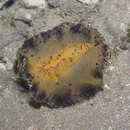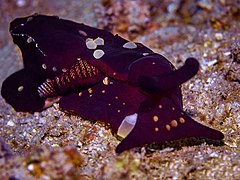en
names in breadcrumbs


Euthyneura is a taxonomic infraclass of snails and slugs, which includes species exclusively from marine, aquatic and terrestrial gastropod mollusks in the clade Heterobranchia.
Euthyneura are characterised by several autapomorphies, but are named for euthyneury. They are considered to be the most successful and diverse group of Gastropoda. Within this taxon, the Gastropoda have reached their peak in species richness and ecological diversity. This obvious evolutionary success can probably be attributed to several factors. Marine Opisthobranchia, e.g., have evolved several clades specialised on less used food resources such as sponges or cnidarians. A key innovation in the evolution of Pulmonata was the colonization of freshwater and terrestrial habitats.[3]
Various phylogenetic studies focused on Euthyneura: Dayrat et al. (2001),[4] Dayrat & Tillier (2002)[5] and Grande et al. (2004).[6] Morphological analyses by Dayrat and Tillier (2002)[5] demonstrated the need to explore new datasets in order to critically analyse the phylogeny of this controversial group of gastropods. Klussmann-Kolb et al. (2008) traced an evolutionary scenario regarding colonisation of different habitats based on phylogenetic hypothesis and they showed that traditional classification of Euthyneura needs to be reconsidered.[3]
Jörger et al. (2010)[7] have redefined major groups within the Heterobranchia and a cladogram showing phylogenic relations of Euthyneura is as follows:[7]
HeterobranchiaLower Heterobranchia (including Acteonoidea) - Lower Heterobranchia does not form a clade in the study by Jörger et al. (2010):[7]
EuthyneuraCladogram showing phylogenic relations of Euthyneura sensu Wägele et al. (2014):[8][2]
Heterobranchia Euthyneura Acteonacea Nudipleura Nudibranchia TectipleuraKano et al. (2016) proposed a new taxon Ringipleura and classified Ringiculoidea as sister group to Nudipleura:[2]
Heterobranchia Euthyneura Acteonacea Ringipleura TectipleuraThis article incorporates CC-BY-2.0 text from the reference[3]
Euthyneura is a taxonomic infraclass of snails and slugs, which includes species exclusively from marine, aquatic and terrestrial gastropod mollusks in the clade Heterobranchia.
Euthyneura are characterised by several autapomorphies, but are named for euthyneury. They are considered to be the most successful and diverse group of Gastropoda. Within this taxon, the Gastropoda have reached their peak in species richness and ecological diversity. This obvious evolutionary success can probably be attributed to several factors. Marine Opisthobranchia, e.g., have evolved several clades specialised on less used food resources such as sponges or cnidarians. A key innovation in the evolution of Pulmonata was the colonization of freshwater and terrestrial habitats.
 Berthella martensi, a pleurobranch with the gill on the right side.
Berthella martensi, a pleurobranch with the gill on the right side. Various phylogenetic studies focused on Euthyneura: Dayrat et al. (2001), Dayrat & Tillier (2002) and Grande et al. (2004). Morphological analyses by Dayrat and Tillier (2002) demonstrated the need to explore new datasets in order to critically analyse the phylogeny of this controversial group of gastropods. Klussmann-Kolb et al. (2008) traced an evolutionary scenario regarding colonisation of different habitats based on phylogenetic hypothesis and they showed that traditional classification of Euthyneura needs to be reconsidered.
Los eutineuros (Euthyneura) son un clado taxonómico de caracoles y babosas, que incluye especies de mar, de tierra y de agua dulce, marinos, moluscos gasterópodos acuáticos y terrestres en el clado Heterobranchia.
Heterobranchia baja (incluye Acteonoidea) - Heterobranchia baja no forma parte de este clado de Jörger
EuthyneuraLos eutineuros (Euthyneura) son un clado taxonómico de caracoles y babosas, que incluye especies de mar, de tierra y de agua dulce, marinos, moluscos gasterópodos acuáticos y terrestres en el clado Heterobranchia.
Les Euthyneura sont une infra-classe de mollusques de la sous-classe des Heterobranchia.
Ce groupe remplace en grande partie les anciens taxons des « opisthobranches » et « pulmonés ».
Ce vaste groupe de mollusques comprend quasiment tous les hétérobranches contemporains (mis à part 8 clades qualifiés d'« hétérobranches inférieurs »), et constitue le groupe de gastéropodes (et sans doute de mollusques) le plus diversifié.
La principale caractéristique qui le définit est appelée « Euthyneurie » : c'est le fait que les organes internes des gastéropodes, normalement torsadés pour pouvoir se loger dans la coquille (phénomène de « streptoneurie ») se sont secondairement redressés dans ce groupe, et rapprochés de la tête[1].
Selon World Register of Marine Species (27 janvier 2019)[2] :
Divers Cephalaspidea[3]
Divers Stylommatophora
Les Euthyneura sont une infra-classe de mollusques de la sous-classe des Heterobranchia.
Ce groupe remplace en grande partie les anciens taxons des « opisthobranches » et « pulmonés ».
Euthyneura Spengel, 1881 è un'infraclasse di molluschi gasteropodi della sottoclasse Heterobranchia.[1] Considerato il numero di specie esistenti e la varietà di nicchie ecologiche occupate, è il raggruppamento che ha avuto, tra i gasteropodi, il maggior successo evolutivo.[2]
Comprende specie terrestri, di acqua dolce e marine, caratterizzate da una condizione anatomica definita eutineuria, ovvero dalla detorsione dei cordoni nervosi e del sacco dei visceri. L'eutineria è il risultato di due distinti eventi evolutivi: il primo, occorso negli antenati di tutti i gasteropodi esistenti, è noto come torsione e comporta il fatto che gli organi viscerali e i cordoni nervosi "si attorciglino" causando la migrazione di alcuni organi dalla sinistra dell'animale alla sua destra e favorendo il trasferimento della cavità del mantello vicino alla testa dell'animale; tale evento ha prodotto un incrocio nelle commessure cerebroviscerali, definito chiastoneuria o streptoneuria. Il secondo evento evolutivo, caratteristico di questo raggruppamento, consiste nell'inversione della torsione, con conseguente "raddrizzamento" degli organi interni, e risoluzione dell'incrocio delle commissure.[3]
L'infraclasse Euthyneura comprende taxa che in passato venivano attribuiti ai raggruppamenti degli Opisthobranchia e dei Pulmonata, ora ritenuti obsoleti.[2][4][5][6] La monofilia del raggruppamento è oggi comunemente accettata e supportata da numerose sinapomorfie.[2]
Secondo la classificazione adottata dal World Register of Marine Species (2020) l'infraclasse può essere suddivisa in 3 subterclassi (Acteonimorpha, Ringipleura e Tectipleura) così composte:[1]
Euthyneura Spengel, 1881 è un'infraclasse di molluschi gasteropodi della sottoclasse Heterobranchia. Considerato il numero di specie esistenti e la varietà di nicchie ecologiche occupate, è il raggruppamento che ha avuto, tra i gasteropodi, il maggior successo evolutivo.
Euthyneura Spengel, 1881 é um clado de moluscos gastrópodes com significado taxonómico, parte do clado Heterobranchia, que agrupa os caracóis e lesmas. Inclui espécies marinhas, terrestres e de água doce.
O clado Euthyneura inclui espécies de Gastropoda de água doce, marinhas, aquáticas e terrestres, pertencentes ao clade Heterobranchia.
Euthyneura é considerado o grupo coroa dos Gastropoda,[2] e agrupa espécies caracterizadas por diversa autapomorfias,[2]- mas recebem a sua designação por serem um caso de eutineuria.
O agrupamento é considerado o mais bem sucedido de entre os Gastropoda,[2] tendo sido dentro deste grupo que os Gastropoda atingiram o auge em riqueza de espécies e diversidade ecológica.[2] Este óbvio sucesso evolucionário pode ser provavelmente atribuído a diversos factores. Entre os Opisthobranchia marinhos, entre outros grupos, evoluíram diversos clades especializados no aproveitamentode recursos alimentares menos utilizados, tais como esponjas e cnidários.[2]
Uma inovação chave na evolução dos Pulmonata foi a colonização de habitats de água doce e terrestres.[2]
Múltiplos estudos têm focado a filogenia dos Euthyneura: Dayrat et al. (2001),[3] Dayrat & Tillier (2002)[4] and Grande et al. (2004).[5] As análises morfológicas demonstraram a necessidade de explorar novos conjuntos de dados para analisar criticamente a filogenia deste complexo grupo de gastrópodes.[2][4] Alguns estudos permitiram comparar o cenário evolutivo proposto com a sequência de colonização de diferentes habitats com base em hipóteses filogenéticas e mostraram que a classificação tradicional de Euthyneura precisa ser reconsiderada.[2]
Com base na informação taxonómica disponível é possível estabelecer o seguinte cladograma:[6]
Heterobranchia (que não forma um clado)[6]Allogastropoda (Heterobranchia inferiores) (incluindo Acteonoidea)
Estudos filogenéticos publicados em 2014 permitem ampliar o cladograma anterior par o seguinte:[7][8]
HeterobranchiaAllogastropoda (Heterobranchia inferiores)
Em 2016 foi proposta a criação de um novo táxon, Ringipleura, o clado Ringiculoidea foi classificado como grupo irmão dos Nudipleura:[8]
HeterobranchiaAllogastropoda (Heterobranchia inferiores)
Euthyneura Spengel, 1881 é um clado de moluscos gastrópodes com significado taxonómico, parte do clado Heterobranchia, que agrupa os caracóis e lesmas. Inclui espécies marinhas, terrestres e de água doce.
직신경류(Euthyneura)는 복족류 분류 중의 하나이다.
2010년 요르거(Jörger)와 그의 공저자들은[2] 이새류에 포함된 주요 분류군을 재정의하면서, 다음과 같이 직신경류의 계통 분류를 나타냈다.[2]
이새류하이새류 (비자고둥상과 포함) - 2010년 요르거(Jörger)와 그의 공저자들의 연구에 의하면, 하이새류는 별도의 분기군을 형성하지 않는다.[2]
직신경류